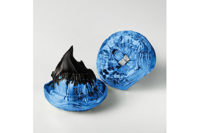A Latex Alternative

More than 40,000 types of commercial products are made from natural rubber latex (NRL), an extract of the Pará rubber tree (Hevea brasiliensis). From surgical bandages to caulks, NRL is used in numerous products in the adhesives and sealants industry. However, out of more than 200 proteins contained within NRL, 13 are known to be allergens. The American Latex Allergy Association estimates that 3% of the general population exhibits some form of latex allergy, thus hindering the use of such products.
Fortunately, a solution exists. It involves a patented process of adding aluminum hydroxide-Al(OH)3, a well-known protein-binding chemical-to NRL while it is still in liquid form. This compound acts as a binding agent to the NRL and produces protein complexes that can be removed using existing industry practices. The result is an ultra-low-protein variant of NRL that retains all of the advantages of the material while reducing the potential for allergic reactions.*

A Safer Class of Adhesives and Sealants
In 1845, the first rubber-based adhesive patent (U.S. patent number 3,965) was issued to Henry Day. Natural rubber latex was the first polymer to be used to produce pressure-sensitive adhesives. Interestingly, NRL is the only material that sticks to itself, making it ideal for cold-seal adhesives. NRL has several key properties that are advantageous when used in pressure-sensitive and contact adhesive formulations. For example, its low glass transition temperature (-70°C vs. polychloroprene at -40°C) and low surface energy enable NRL to flow effectively over surfaces.As Jim Judson and Michael J. Dochniak noted in the October/November 2009 issue of this magazine, NRL-based waterborne adhesives are widely used for carpet backing and installation; specialty paper, including envelopes and labels; flooring and tile bonding; food and medical packaging; custom stock napkin and shirt bands; currency straps; foam fabricating; and shoe adhesives. As for latex-based sealants, many popular commercial brands are available at home improvement and hardware stores. “Although many of the allergenic hazards of NRL adhesives are well understood,” they wrote, “exploitation and a comfortable dependence on such a material continue to affect the incidence of latex allergies.”1
In addition to the elimination of most of the proteins that can trigger allergic reactions in certain individuals, the use of Al(OH)3-modified NRL can offer additional benefits. Using an industry-standard, air-assisted Graco spray gun with an air inlet pressure of 40 PSI and spray orifice of 0.07-0.086 units, a comparison study between a standard low-ammonia latex and the Al(OH)3-modified NRL was performed to assess the overall spray ability. The latex spraying process resulted in no clogging of the spray head, and the viscosity and stability were found to be acceptable. The tack of the latex samples was found to be comparable to traditional NRL. All films dried clear without any observable inclusions or irregularities.
Significantly, the Al(OH)3-modified NRL, having ultra-low-protein content, has exceptionally high shear stability compared to traditional NRL. Furthermore, gel times can be customized through the use of additives to suit one’s specific application needs. Manufacturers have been pleased with the processing characteristics of the Al(OH)3-modified NRL in both spray and roll coating applications.
In addition, many cohesive medical bandages use NRL as a co-bonding agent; however, the material can pose the risk of provoking a sensitive skin reaction if not modified to permanently reduce the antigenic proteins. Bandages produced with an Al(OH)3-modified NRL-formulated adhesive have been found to exhibit a 20-fold lower protein content than bandages made with traditional NRL. This is of particular importance in adhesive applications where the leaching and/or washing that are typically used to reduce protein content cannot be performed.
Modified NRL demonstrates greater stability than traditional NRL while maintaining all of natural rubber latex’s positive performance characteristics. A combination of greatly reduced protein, improved processing, and effective adhesion makes the Al(OH)3-modified NRL a prime option for the next generation of NRL adhesive.

Figure 1. Reacted Al(OH)3 complexes are removed by a combination of filtration and centrifugation.
Manufacturing a Low-Allergen Latex
Due to its availability, ease of production and the performance characteristics of latex products, NRL is a preferred raw material for product manufacturers and users worldwide. Its proven biodegradability makes it the material of choice in our increasingly environmentally conscious society. Unlike most synthetic alternatives, the patented process of Al(OH)3-treated NRL uses green chemistry to modify pure natural rubber latex. This Al(OH)3-modified NRL, derived from the rubber tree, remains 100% natural. In contrast, many synthetic alternatives to latex, such as PVC, styrene, nitrile, choloroprene and polyurethane, which are made from petrochemical derivatives, are neither biodegradable nor compostable. Unlike such synthetic alternatives, the Al(OH)3-modified NRL has minimal impact on the environment and features biodegradability similar to an oak leaf.The patented process for creating the Al(OH)3-modified NRL removes specific non-rubber impurities from NRL through the directed application of Al(OH)3. A commonly used absorbent, emulsifier, ion-exchanger and antacid, Al(OH)3 is commonly used in water purification. It forms a jelly-like structure, suspending any unwanted materials (including bacteria) in water. Using traditional processing methods, a slurry of Al(OH)3 is strategically added to the pure NRL. The effective binding of protein and other non-rubber impurities from the pure latex emulsion to insoluble Al(OH)3 occurs, with some of the non-rubber impurities adsorbed to the reactive surface of the Al(OH)3 crystals.
Since this patented processing step is integrated into the traditional latex manufacturing stage, there is no added capital equipment expense. Reacted Al(OH)3 complexes are removed by a combination of filtration and centrifugation (see Figure 1). The remaining rubber particles retain the surrounding lipid layer, which, during subsequent maturation, improves the mechanical stability of the latex as higher fatty acids are formed. Scientists have observed that this process yields products that exhibit greater clarity, improved translucency and significantly reduced odor, in addition to fewer antigenic proteins, without sacrificing the properties that give traditional NRL its advantages over synthetic alternatives. Prior industry efforts have produced low-antigenic-source latex through the treatment of raw latex with enzymes, but they have not achieved widespread market adoption.
Additional Advantages
Within the latex-dipped goods industry, manufacturers using Al(OH)3-modified latex have demonstrated increased efficiency by reducing processes such as the excessive washing and leaching typically used to reduce protein levels in traditional NRL. This reduction can significantly lower water and energy consumption while simultaneously reducing the presence of harmful leachates such as zinc. The overall environmental impact is minimized, resulting in production cost savings and resource conservation.Al(OH)3-modified NRL is slightly more expensive than traditional NRL, but it is priced comparably (or even less expensively) to alternative materials and provides significant cost value when compared to other synthetic materials. In addition, it has been shown that manufacturers can reduce production costs when using Al(OH)3-modified NRL, potentially offsetting the incremental acquisition costs.
Raw, natural latex is a liquid. When dried and cured, the film dries semi-transparent yellow. Manufacturers can add whitening agents, such as titanium dioxide or calcium carbonate, to the latex to express whiteness in the finished product or to provide a white background for which color pigments can be used. Because the Al(OH)3-modified NRL is characteristically whiter in appearance than traditional latex, whether treated or not, its use reduces the amount and cost of the sometimes-expensive whitening agents. This allows manufacturers to offer enhanced pigmented products with reduced pigment use and cost.
A Viable Alternative
Manufacturers continue to see the value in this Al(OH)3-modified NRL, allowing them to increase production efficiency. It is critical to recognize the need and importance of natural products that minimize the environmental impact while maximizing economic, health, and safety benefits. This need is addressed by commercializing the patented process of modifying NRL while enhancing its attributes and performance. The process of using Al(OH)3 eliminates a significant portion of proteins and other non-rubber compositions in latex, producing cleaner, whiter products with significantly reduced odor over traditional NRL.The use of Al(OH)3-modified latex is thus a logical upgrade for manufacturers that use traditional latex across a range of industries, including adhesives and sealants manufacturing. The overall performance benefits and attributes of Al(OH)3-modified latex offer a unique value proposition to manufacturers, allowing them to capitalize on its green advantages while addressing health and safety concerns. In addition, the potential production cost saving opportunities make Al(OH)3-modified latex a sensible material of choice for future generations.
For more information, contact Vystar Corp. at 3235 Satellite Blvd., Bldg. 400, Ste. 290, Duluth, GA 30096; phone (770) 965-0383; fax (770) 965-0162; or visit www.vytex.com.
Reference
1. Judson, Jim, and Dochniak, Michael J., “Greener Natural Latex Adhesives,” Adhesives & Sealants Industry, October/November 2009, pp. 19-20.Links
Looking for a reprint of this article?
From high-res PDFs to custom plaques, order your copy today!






